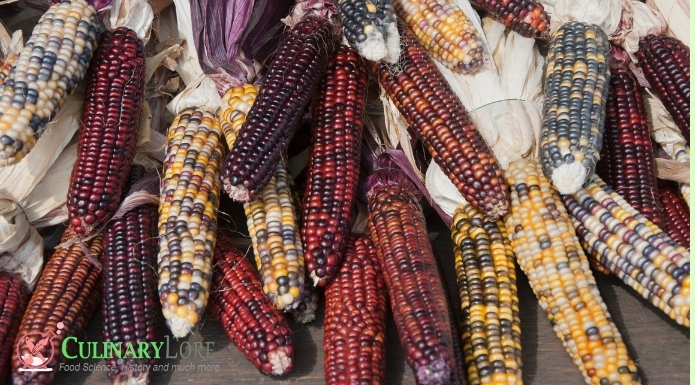Corn was completely unknown in Europe, Asia, and Africa before the 16th century, when the Spanish brought it over to Europe from the New World. They didn’t call it corn, but rather maize. The word maize comes a word of the Taino people of the Caribbean, mahiz. Although we are not sure which island, exactly, it was presumably somewhere in the northern Antilles, near San Salvador. The word mahiz, to the Tahino, meant “source of life.” To them, corn was a staple food, as it is to many of us today. The Spanish did not change the name; they only transmuted it to maiz, which became maize in English.

To understand how maize came to be called corn, first, think about all the food words that have corn in them, but have nothing to do with the grain maize. Peppercorns, for instance, are the dried berries of the Piper nigrum plant. Nothing to do with maize. And, have you ever wondered about corned beef? There’s no corn in it, so how is it “corned?”
Well, although some sources will tell you that corn was a word for grains (any grains), it was a word meaning “small nugget” and, if you think about it, grain can mean the same thing. A grain of sand, a grain of salt. The word grain is applied to any small particle.
Corn was similar to the word grain except it had the connotation of something that is ground down into small particles. The word corn is linked to an Indo-European word of uncertain spelling but something like grn, which produced grnom, meaning a small worn down particle, and also the word kurnam in prehistoric German, which developed into the English corn.
The Latin word granum, the source of the English grain, came from the same root. It developed very early to refer to small particles or small seeds, specifically the seeds of cereal grains.
The original meaning survives in very few words. Peppercorn, referring to the small berries of the pepper vine is obvious. In corned beef it refers to beef being rubbed or preserved with “corns” or grains of salt. And unknown except to skiers, is corn snow, which refers to a granular, coarse type of snow. The English word kernel is also related to corn and comes from a diminutive Old English form of the word.
When applied to cereal grains, terms like wheat, corn, or barleycorn were used, but corn would tend to be applied to the leading grain of a region. So, in England, corn was wheat, or wheat corn; in Scotland and Ireland, corn was oats.
Although the original maize name was retained when corn was brought to Europe, in some places, people did not know that it was from the New World, so names like Welsh corn, Asiatic corn, or Turkish corn were sometimes used.
Applying Turkish, Turk, or Turkey to an exotic food was quite common, as when the Turks had invaded Europe, they had brought over many new foods, so often any new food was assumed to be of Turkish origin. Applying an “Asian” origin to foods was pretty much the same idea. These were exotic and unknown lands, full of exotic and unknown foods.
So, now we know how the word corn was used in Europe. But when the English “Pilgrims” settled in the New World, they used the catchall term for any type of grain and applied it to maize, calling it Indian corn. When corn came to be such an important part of US food production, the “Indian” part was left behind, and the word corn eventually became a legal term applied to maize.

What is Maize, Actually?
Maize is a grass, like all cereal grains. It belongs to an order of grasses called Gramineae. Gramineae has two genera: Tripsacum and Zea. The species Zea mays is what we know as corn.
Zea mays was derived from a wild grass called teosinte. This grass had only a few very small grains on a ‘head’ but eventually evolved, through cultivation into modern corn. Corn was domesticated in Mexico and Central America very early on in history and it is unique in that it cannot disperse its seeds without the intervention of man. Without humans cultivating and spreading it, it would not survive.
Is Corn a Fruit, Grain, or Vegetable?
As above, corn or maize is a cereal grain of the grass species Zea mays. Grain is also known as a caryopsis, which, botanically, is a special kind of dry one-seeded fruit. Each grain of corn is a separate fruit, and unlike other fruits, you cannot easily separate the pericarp, or seed coat, from the inner parts of the seed, the endosperm and the embryo, except by a milling process. This is a characteristic of all cereal grains except buckwheat. So, corn a grain, is a type of fruit, and therefore corn is both.
Corn is eaten as a grain and as a vegetable. Here, we are using the word grain in the culinary sense rather than the botanical sense. Vegetable, on the other hand, is not a botanical term at all, but only a culinary term. So, corn is whatever you want it to be, in terms of cooking and eating it. 1Small, Ernest. Top 100 Food Plants. Ottawa: NRC Research, 2009.,2La, Boone John A. Around the World of Food: Adventures in Culinary History. New York: IUniverse, 2006.,3Ayto, John, and John Ayto. Word Origins: The Hidden Histories of English Words from A to Z. London: & C Black, 2005.4Smith, Andrew F. The Oxford Companion to American Food and Drink. Oxford: Oxford UP, 2007.,5Bowman, Melville L. Corn; Growing, Judging, Breeding, Feeding, Marketing; for the Farmer and Student of Agriculture, a Text-book for Agricultural Colleges and High Schools. Iowa: Author, Sold by Waterloo, 1881.











